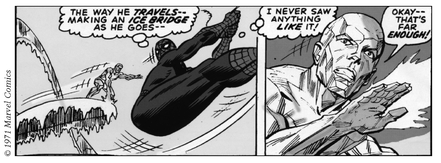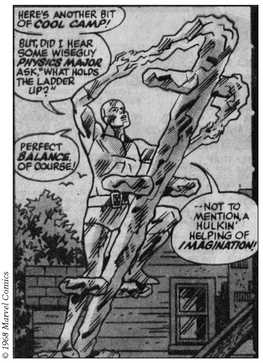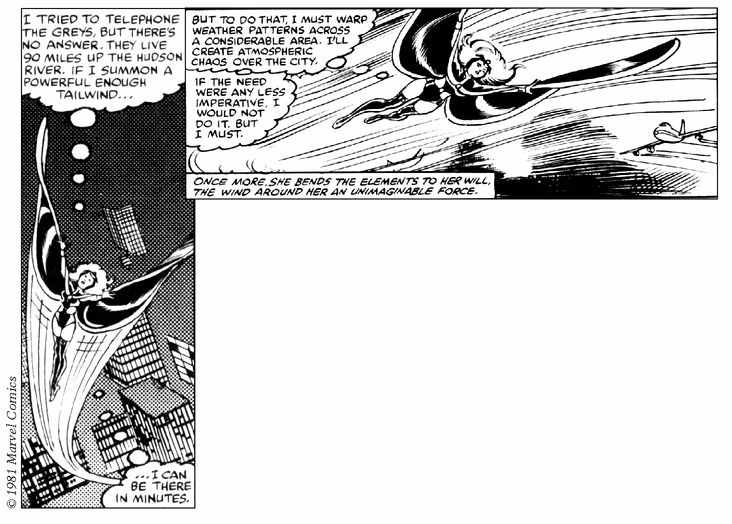The Physics of Superheroes: Spectacular Second Edition (29 page)
Read The Physics of Superheroes: Spectacular Second Edition Online
Authors: James Kakalios

BOOK: The Physics of Superheroes: Spectacular Second Edition
13.11Mb size Format: txt, pdf, ePub

As his mastery of his mutant ability progressed, Iceman was able to project “freeze rays” from his hands, icing up another person or object, or even creating a large mountain of ice beneath his feet. To get around while fighting such evil mutants as Magneto, the Blob, or the sinister, robotic Sentinels, Bobby would frequently generate an “ice slide” underneath his feet on which he would glide, as illustrated in fig. 22. Bobby would, in principle, create a large ice mountain underneath himself and then generate a ramp on which he would slide to his intended destination. Well, this in itself would not violate any physics principles, assuming, of course, that one could indeed control local temperatures in this manner and that there was sufficient humidity in the air to create all this ice. What is troubling, however, is the apparent stability of Bobby’s ice slides, no matter how long they became. At some point, Bobby would get out in front of the center of mass of his ice slide—a point at which one would expect bad things to happen.
The “center of mass,” also referred to as the “center of gravity,” is the point at which an object behaves as if all of its mass, no matter how much or how unevenly distributed, were concentrated at this one location. A yardstick would have its center of mass located exactly at its center. You can balance the yardstick across your index finger, held so that it lies parallel to the ground, but only if your finger is underneath this midpoint. Placing your supporting finger too close to either end will cause the stick to rotate and fall. The center of mass depends on the distribution of matter in the object. A baseball bat, thicker and heavier at one end, will have its center of mass closer to the wider end than to the narrower handle.
To see why Bobby’s ice slides cannot extend too far without crumbling, place a book on a table. The weight of the book is directed toward the ground and is balanced by a force from the table. The center of mass is in the middle of the book, and as long as it is on top of the table, the book is stable. But now slide the book near the edge of the table. At first a small fraction of the book can hang over the edge of the table with no problem. The portion of the book that’s over the edge creates a twisting force, a torque. This unsupported weight of the book tries to rotate the book, but there is more weight over the table, trying to rotate the book in the other direction, so the book remains stationary. But as you slide the book farther, so that its center of mass is no longer above the table but over the side, the book will rotate and flip onto the floor.

Fig. 22.
Scene from
Amazing Spider-Man # 92,
where the mutant X-Man Iceman battles Spider-Man due to a mistaken impression (such confusion that would lead two heroes to fight until they realized that they were on the same side occurred no more often in Marvel comics than once or twice—a month). It’s no surprise that Spidey has never seen anything like Iceman’s ice ramps, as they display questionable stability when the mutant hero ventures far beyond the ramps’ centers of gravity.
Scene from
Amazing Spider-Man # 92,
where the mutant X-Man Iceman battles Spider-Man due to a mistaken impression (such confusion that would lead two heroes to fight until they realized that they were on the same side occurred no more often in Marvel comics than once or twice—a month). It’s no surprise that Spidey has never seen anything like Iceman’s ice ramps, as they display questionable stability when the mutant hero ventures far beyond the ramps’ centers of gravity.
Similarly, when Iceman’s slides become too extended, he moves too far from the center of mass of the ice mountain he’d originally generated. Rather than flipping his ice ramp and mountain, it is more likely that the torque that results from him gliding along its edge becomes greater than the strength of the ice slide, and his slide should break off. In order to satisfy basic mechanics, Bobby Drake should continually reinforce the underside of his ice slides with ice pillars, in order to avoid getting too far in front of their center of mass. Sometimes the implausible mechanical stability of Iceman’s constructs would be acknowledged, as indicated in fig. 23 from a backup feature “I, the Iceman” in
X-Men # 47.
If any “wiseguy physics majors” wonder what keeps Iceman’s ladders and ramps aloft, the answer, which no one can refute, is “a hulkin’ helping of imagination!”
X-Men # 47.
If any “wiseguy physics majors” wonder what keeps Iceman’s ladders and ramps aloft, the answer, which no one can refute, is “a hulkin’ helping of imagination!”

Fig. 23.
A scene from
X-Men # 47,
where Bobby Drake (Iceman) talks directly to the reader about the mechanisms underlying his mutant freezing powers and gives a knowing wink that he recognizes the physical implausibility of some (OK, all) of his uncanny feats.
A scene from
X-Men # 47,
where Bobby Drake (Iceman) talks directly to the reader about the mechanisms underlying his mutant freezing powers and gives a knowing wink that he recognizes the physical implausibility of some (OK, all) of his uncanny feats.

The X-Men comic in its first incarnation in the 1960s was not a major sales success, and original stories ceased publication in 1970. Five years later, new management at Marvel Comics decided to try a revival of the X-Men, and the
All-New, All-Different X-Men
(written by Len Wein and drawn by Dave Cockrum), as their debut giant-size issue was titled, was a financial success from the very beginning. Despite the promise implied by the title, some of the X-Men characters featured in this issue were from the original team, but many of the new characters that debuted, such as Ororo Munroe (Storm); Logan (Wolverine); Peter Rasputin (Colossus); and Kurt Wagner (Nightcrawler) would go on to become fan favorites.
All-New, All-Different X-Men
(written by Len Wein and drawn by Dave Cockrum), as their debut giant-size issue was titled, was a financial success from the very beginning. Despite the promise implied by the title, some of the X-Men characters featured in this issue were from the original team, but many of the new characters that debuted, such as Ororo Munroe (Storm); Logan (Wolverine); Peter Rasputin (Colossus); and Kurt Wagner (Nightcrawler) would go on to become fan favorites.
Not everyone was impressed, however. Stan Lee has been quoted as complaining about the implausibility of Storm’s mutant ability to control the weather. He did not seem bothered by Colossus’s ability to transform his skin into “organic steel” (I have absolutely no idea what this phrase means, or how this power could possibly work in the physical world) or Nightcrawler’s teleportation power (well, if you give me enough “miracle exceptions,” I suppose I could try to make this work), but “weather powers” seemed too implausible for the man who brought the world the Incredible Hulk and the Silver Surfer (if he travels through outer space, what exactly is he surfing on?).
48
But Stan should not be too quick to throw stones at superhero houses. The same mutant power manifested by one of Stan’s own creations, Iceman of the original X-Men—the ability to generate and control thermal gradients—also enables Storm to influence meteorological phenomena.
48
But Stan should not be too quick to throw stones at superhero houses. The same mutant power manifested by one of Stan’s own creations, Iceman of the original X-Men—the ability to generate and control thermal gradients—also enables Storm to influence meteorological phenomena.
At its core, the weather is simply a matter of the atmosphere absorbing energy in the form of sunlight, and is in fact so simple that it is nearly impossible to accurately predict. When one thinks of weather, terms such as “wind,” “rain,” and “snow” come to mind (particularly if, like me, you live in Minnesota). All are governed by spatial differences in temperature, driven by variations in the amount of sunlight energy absorbed by the atmosphere.
Spatial variations of the atmospheric temperature are associated with changes in the atmospheric density (the number of air molecules in a given volume). When a volume of denser air is adjacent to a dilute region, there will be a net flow of air from the high-to low-density spaces until the density in each volume element is equal. This flow of air can be understood simply on the basis of the entropy argument discussed in the previous chapter. If there is a constant input of energy, keeping one region at a lower density than another, then this flow of air—or wind—will persist. The wind can, in turn, move cloud cover, changing the spatial pattern of sunlight absorption, which changes the airflow trajectories that influence the cloud cover, and so on. Of course, the Earth’s rotation determines the global direction of air circulation.
The ability to accurately predict the weather is therefore limited by the precision with which one knows, at some specified time, the air speeds and temperatures everywhere in space. Furthermore, changes in temperature lead to airflow that in turn changes the absorbed sunlight, leading to new airflow patterns. There is a nonlinear feedback in place, such that any small uncertainty in our knowledge of the initial conditions quickly becomes magnified. In a linear system a small change in the input results in a corresponding small variation in the output, while for nonlinear systems, such as the weather, a small change could lead to a very large variation in the output. This has become popularly known as “the butterfly effect,” whereby the beating of a butterfly’s wings in Cleveland may, several weeks later, produce tornado-like conditions in Chile. Meteorologists do an excellent job of predicting the weather in the short term, but anything beyond a few weeks is intrinsically unreliable, regardless of the quality of the measurement systems.
A physically plausible explanation for Storm’s ability to control the weather is that she is able to alter atmospheric temperature variations in space and time at will. The wind that allows Storm to fly, as illustrated in fig. 24, is created by a temperature gradient beneath her. Storm presumably uses her mutant power to make the region of air under her hotter than that above her. The temperature of the air is a measure of its average kinetic energy, so air at a very low temperature is moving much slower than warmer air. This cooler air is denser, and it will fall toward the ground. The faster-moving, less dense “hot” air molecules will occupy the space left vacant by the falling “cold” air molecules, simply because if they are zipping around at great speeds, colliding with one another, there are many more ways they can scatter into unoccupied regions than if they collide and always manage to stay near the ground. The average kinetic energy of the hot air molecules is large; consequently, the gravitational potential energy is only a small addition to its total energy. Once the hot air molecules are near the cold upper region, and the cold air molecules are near the ground, the lower molecules will gain energy from collisions with the heated ground, and the hot air will lose energy following collisions with the cool air above it. There will once again be a situation where hot air is on the ground and cold air is above it, and the cycle will continue.
This process is termed “convection” and such thermal convection rolls are an extremely efficient way to transfer energy from a hot source to a cold one through the thermal link of the air in the room.

Other books
Lone Rider by B.J. Daniels
In the Eye of the Storm by Jennifer Hayden
3stalwarts by Unknown
Call Out by L.B. Clark
Diving Into Him by Elizabeth Barone
The Last Keeper by Michelle Birbeck
All in the Family by Taft Sowder
The Girl with the Golden Spurs by Ann Major
The Wicked Bad (Crimson Romance) by Gerrard, Karyn
